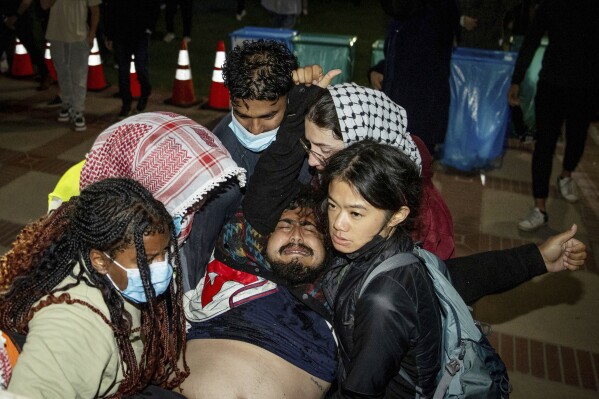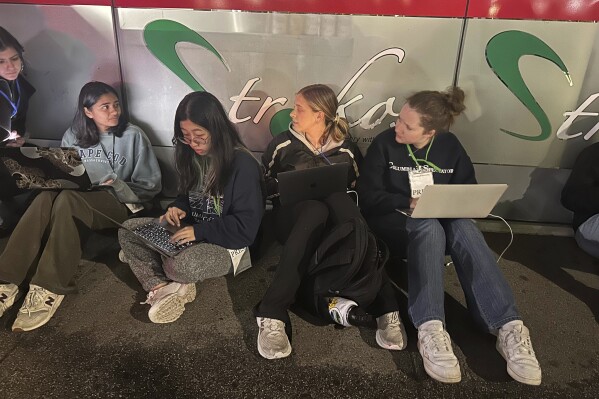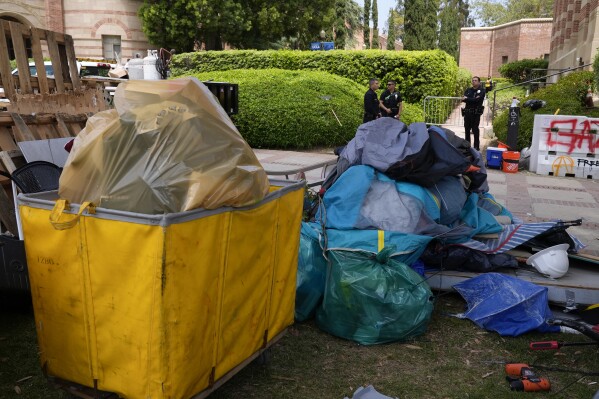Answering readers’ questions about the protest movement on US college campuses
A wave of demonstrations has spread across U.S. campuses over the last two weeks, led by students who have pitched tents or occupied buildings in protest of the Israel-Hamas war.
It started April 18 when police moved to break up an encampment at Columbia University in New York City. Since then, it has spread to dozens of other campuses from Harvard to the University of California, Los Angeles.
Students are calling on their colleges to stop doing business with Israel or companies they say support the war in Gaza. Some also have asked for amnesty for student protesters who could face suspensions or other discipline.
University officials have negotiated deals with protesters at campuses including Northwestern University. Others have called the police to clear camps or campus buildings, as happened at UCLA.
At least 2,000 people have been arrested at campus protests nationwide in the last two weeks, according to a tally by The Associated Press.
Here are some questions readers sent to the AP, lightly edited for publication.
How many protesters are not students and who are they? Are there outside agitators?
City and campus leaders in some places have alleged protests are being led by “outside agitators” with no connection to universities. Student protesters have rejected the claims. Those who are arrested often include a mix of students and non-students. Some claims about agitators have failed to hold up.



New York City Mayor Eric Adams alleged that “outside agitators” had co-opted the Columbia University demonstration before police officers came and arrested more than 100 people on Tuesday night. Adams referenced a woman whose husband was “convicted for terrorism.”
The woman he cited, Nahla Al-Arian, wasn’t on the campus, isn’t among those who were arrested and has not been accused of any crime.
The New York mayor has also noted many of the tents in the encampment were the same brand — more evidence of agitators, he said. Students who organized it said the tents were simply ordered in bulk.
Others have made similar claims elsewhere. After breaking up a demonstration at Northeastern University in Boston, campus officials said it had been “infiltrated by professional organizers.” Students denied it.
What is the real endgame here? One article states they want the universities to separate themselves from companies furthering Israel’s military efforts. What companies are these?
Pro-Palestinian activists are demanding that universities cut financial ties with Israel and companies that they say support it. Specific demands vary by campus.
On many campuses, students say they don’t know the extent of the campus ties with Israel. Yale is one of many campuses where students are demanding transparency around investments. The school doesn’t make all its investments public, and money can be hard to track after it goes to outside investment managers hired by colleges.
Activists in some places have identified specific ties they want to end. Students at the University of Michigan said the school sends billions of dollars to investment mangers that profit from the war. They cited investments in firms that produce drones and surveillance technology used in Israel.
Michigan officials said they have no direct investments with Israeli businesses and that direct investments make up a fraction of 1% of the $18 billion endowment.
Protesters at the Massachusetts Institute of Technology are also demanding an end to research contracts from Israel. They have published the names of researchers who accept money from Israel’s defense ministry for projects that they say help with drone navigation and missile protection.
As for the endgame, a big part of the protests is visibility — protesters say they want their message heard around the world. In that, they have succeeded, as demonstrations have led news coverage in areas including the Middle East.
What percentage of college campuses across America have witnessed violent pro-Palestine protests?
It’s hard to know the exact percentage, but it’s relatively small. More than 2,000 people have been arrested across more than 30 colleges.
By comparison, the U.S. has about 6,000 colleges and universities, including all types of institutions. Those schools serve roughly 18 million students, including undergraduate and graduate students.
Protests have spread to dozens of campuses across the country but violence has been relatively rare.
How does this situation compare and contrast with the student protests in the 1960s? Is there historical context to these protests that could illuminate the current situation?
The wave of protests is among the largest on U.S. campuses in recent history, but it’s still nowhere near as widespread or as violent as student demonstrations of the Vietnam War era.
Some historians say the movement might be the largest of the 21st century, but it doesn’t have a whole lot of competition.
And so far, the violence has paled in comparison to that of previous eras. There have been no bombings, for example, like the one in August 1970 at the University of Wisconsin that killed a researcher. And there has been no repeat of the infamous Kent State massacre.
Still, the movement has drawn comparisons to that era, especially with its roots at Columbia and its echoes of a 1968 protest in which students took over campus buildings to protest the Vietnam War.
Disclaimer: The copyright of this article belongs to the original author. Reposting this article is solely for the purpose of information dissemination and does not constitute any investment advice. If there is any infringement, please contact us immediately. We will make corrections or deletions as necessary. Thank you.



